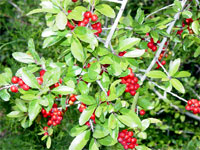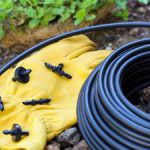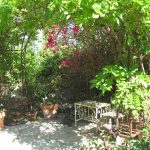Traditional WaterSaver landscapes utilize low-water-use plants for the appearance of a traditional American lawn, without their high water counterparts.
The typical American lawn was brought to America from France and England in the 1700s and promoted at the turn of the nineteenth century by the U.S. Department of Agriculture, the U.S. Golf Association and the Garden Clubs of America as the middle-class ideal.
This landscape style is dominated by a close-cropped lawn of turfgrass and a few hedges and shade trees. This landscape, as it is reproduced in San Antonio with St. Augustine grass generally uses more water, fertilizers, and pesticides than other options.
For those who prefer the neat, clean appearance of a traditional American lawn but want to use less water and fertilizers can substitute low water use plants for their high water use counterparts. This type of landscape style is a Traditional WaterSaver landscape.
Elements of a Traditional WaterSaver Landscape
- Use of low water use grass or low growing ground covers.
- Use of low water use evergreen shrubs
- Colorful perennials in place of annuals
- Shade trees
 |
| Dwarf Yaupon Holly is an evergreen shrub with attractive red berries during the winter months. |
Plants for Manicured Xeriscape Landscape:
- Trees – live oak, red oak, bur oak, cedar elm, redbud, crape myrtle
- Shrubs – Possomhaw holly, Dwarf Yaupon Holly, wax myrtle
- Perennials – Salvia, society garlic, Katie Ruellia, giant liriope, monkey grass, pink skullcap
- Ground Cover and Turf – Asiatic jasmine, Zoysia grass (shade or sun), Bermuda grass (in sun)
Basic Maintenance Requirements:
- Replenish mulch once or twice a year
- Trim ground cover four times annually
- Mow and edge during the growing season if turfgrass is present
Irrigation Requirements
Ground covers and low water use turf need little supplemental irrigation once established. As little as once every two weeks during the summer in the absence of rain. Irrigation can be with a sprinkler maintained in good working order (check weekly for broken or misaligned heads). Irrigation systems should have a rain sensor, be set on manual, and checked regularly for maintenance.
Other Input Requirements
- Soil – The most beneficial input you can give your yard is a good start with good soil. Loamy top soil worked into native soil at least 6 inches deep can benefit new plants. If your yard has rock close to the surface you should carefully select plants that do well in shallow soils.
- Mulch – Shrub and perennial beds and trees can be mulched with organic mulch such as shredded brush (up to 6 inches).
- Pesticides and Fertilizers – Most Manicured Xeriscapes contain only six to eight plant species. Chose those least susceptible to pests or disease. You should always identify the pest or disease in your landscape before choosing the appropriate herbicide, fungicide or insecticide. Contact your Cooperative Extension Service agent for help. Fertilizers may be needed once a year depending on plant selection.




